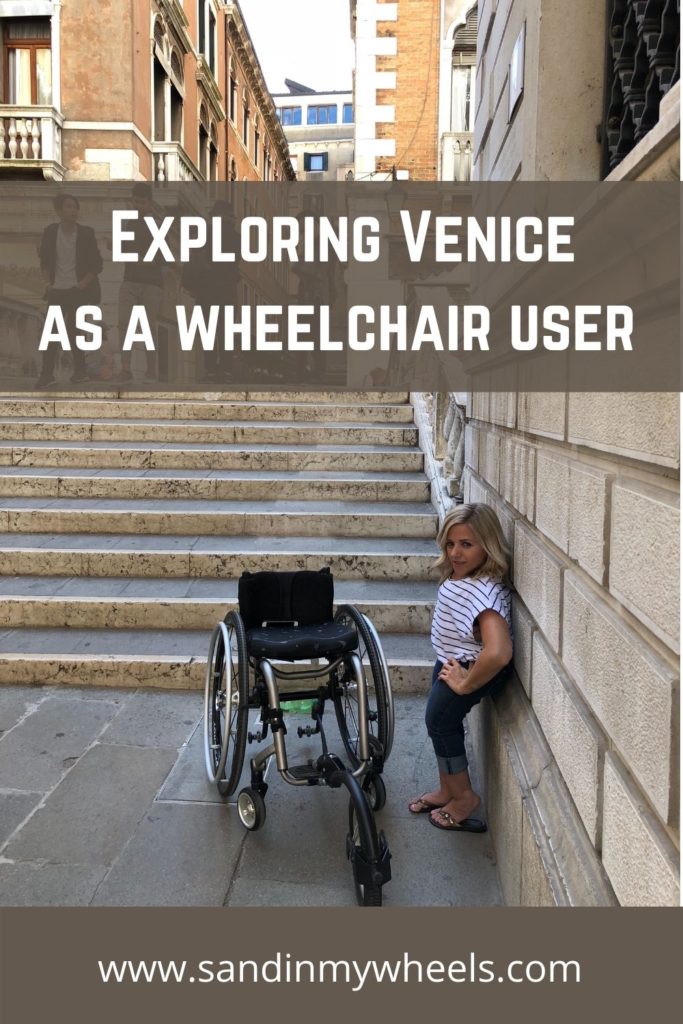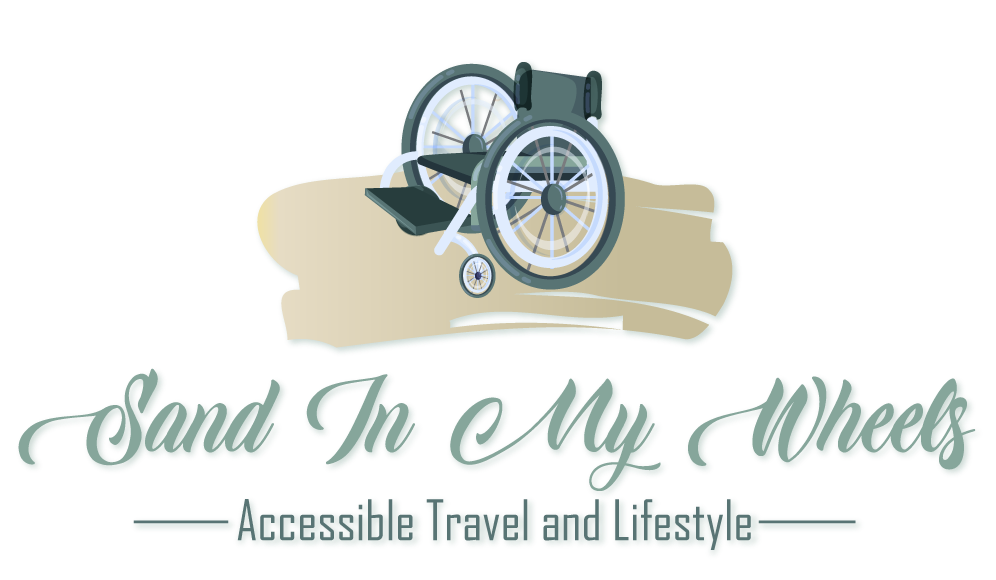Oh Venice, truth be told, I was scared of you before we met. I was warned about you. I saw the pictures, the videos. Stairs. Lots of them. Bridges made of stairs, lurking around every corner. Boats. Small ones. Crowded ones. Old ones. Boats conventionally do not jive with wheelchair accessibility. I imagined barriers truly at every 100 meters or every 20 pushes. Venice, you looked so daunting… and yet, oh so magical, so intriguing. I had to experience you for myself. And so, I went. Armed with pages of research and links and notes… and patience… and Mark. And…. I LOVED Venice!! Like most times in life, my worry was for naught. In fact, in some ways I found Venice to be more accessible than some of the other Italian cities we visited. Here’s why:
– There are really no cars. This means no traffic to weave in between, no giant curbs to get up and down, and no narrow sidewalks.
– The ground was less cobblestoney than other Italian cities we visited. The ground was made up of stones that were larger, flatter and smoother, making for a pretty easy roll, especially with my FreeWheel.
– There are many wonderful outdoor restaurants set up right in the middle of open squares making for very easy access.
– Some of the larger, more popular bridges do have ramp access. (See image in my picture gallery below). The ramps are steeper than North American standards but definitely doable in a power chair or with a bit of help.
– The people are very helpful and friendly! More often than not, when we did come to a staired bridge without a ramp and Mark had to pick me up, a stranger followed behind within seconds, carrying my wheelchair.
– The main mode of transportation throughout the city is by water, and the public water buses, (called vaporettos), were more accessible than I imagined with ramps up and onto waiting platforms and only small curbs (depending on the tide) onto the boats.
We had originally planned for just 2 nights in Venice at the very start of our Italy trip. But when we were met with stormy weather in Sardinia half way through our trek, we completely changed our itinerary on the spot and threw in extra stops to Rome, Milan and an additional night in Venice before flying home. While I was pleasantly surprised with the accessibility in Venice, there are still staired bridges throughout the city, and if you are unable to get out of your wheelchair or have your wheelchair carried, then extra planning will be required.
My advice for successfully conquering, and thoroughly enjoying Venice, in a wheelchair:
– Before booking, get familiar with the general layout of Venice. Venice is divided into a number of different neighbourhoods – Cannaregio, Castello, Dorsoduro, Lido, San Marco. Staying in one neighbourhood versus another will have it’s own pros and cons. For example, booking a hotel in Cannaregio will put you close to the train station and be a bit easier on the budget, but will be further away from some of the main attractions in the San Marco area. Staying in San Marco will put you in the heart of the action, but can be too busy and touristy for some people. A simple map outlining the regions of Venice can be found here.
– Before booking, make a list of the sites you most want to see, (see my recommendations below), as the things you want to do may help you decide on a location for your hotel. Don’t hesitate to email hotels and ask them how many staired bridges stand between the hotel and the various attractions you plan to visit.
– Make use of the public water bus (vaparetto). The water bus is quite accessible and inexpensive so it might be easier to get on and off a water bus than try to get yourself up and down a staired bridge.
– Email potential hotels before booking to confirm they have an elevator/lift as well as the size of the lift. Elevators in the hotels we stayed in throughout Italy were very small and may not have accommodated a larger wheelchair.
Our experience:
Accomodation
A La Commedia: Located in San Marco region. The closest water bus stop is ‘Rialto Bridge’ and there are no staired bridges between this stop and the hotel. This hotel has an accessible main entrance, elevators (although small), accessible rooms (e.g. slightly larger, roll-in shower), and an accessible breakfast area. There is also a wonderful rooftop patio, but there is a single step to access. There are no staired bridges between this hotel and many fabulous restaurants and shops. There are 1-2 staired bridges between this hotel and most of the main attractions (ie: Piazza San Marco).
Carnival Palace: Located in Cannaregio. The closest water bus stop is either ‘Guglie’ or ‘Tre Archi’ and there are no staired bridges between these stops and the hotel. This hotel has an accessible side entrance by way of lift, elevators, (still on the small side), rooms that were accessible enough for me in my manual wheelchair, (we did not check if they had rooms specifically designated as accessible), and an accessible breakfast area. This hotel is right on the canal and there are no staired bridges to reach a number of yummy restaurants, shops and alleyways to explore.
Things To See and Do
St. Mark’s Square (Piazza San Marco): A large open square, lined with restaurants, busy with people and pigeons, and having the impressive St. Mark’s Basilica as it’s backdrop. We loved just being there, taking in the surroundings, people watching, and snapping way too many photos. I recommend getting up early at least one morning and having the square nearly to yourself!
St. Mark’s Basilica: The most famous church in Venice, at the east end of St. Mark’s Square. Magnificent exterior and, as we hear, interior. We attempted to go in for a self guided tour, but had a large bag with us that we were told we’d have to check first. We got lost trying to find the bag check aaaaand then I got hungry, and when I get hungry, food needs to get in my belly, fast, and so we never made it inside! But the side entrance appeared accessible and the website confirms that most areas inside are wheelchair accessible.
Doge’s Palace: Located right next to St. Mark’s Basilica. We didn’t make it in here either, but as with St. Mark’s Basilica, their website indicates pretty decent wheelchair access.
Campanile di San Marco (Bell Tower): Also located in St. Mark’s square, next to St. Mark’s Basilica, we loved the views from this 323 foot structure. There were 2-3 steps to get inside the base of the tower, but then you’ll have elevator access up to the top. Make yourself visible to the staff and they’ll usher you right in. The views at the top are incredible. Seeing the city from this perspective was like no other city I’ve seen. The viewing area was a bit crowded and we had a wait a minute or two to get right up to a window. The window height is probably just over 4 feet so if you’re sitting in a wheelchair you may have to play with camera angles if you’re trying to get a selfie with the city in the background 😉
Bridge of sighs: I’ll admit, this was a little underwhelming to look at, but a good view is easily accessible from a ramped bridge by the water, just a short walk from St. Mark’s Basilica, so, I say why not take the opportunity to snap your own picture of one of the most photographed bridges in Italy. And I think the history behind the bridge and its name is neat.
Gondola ride: Is there really anything more iconically Venice than a gondola ride? But looking at these long skinny boats, rocking away on water, I wondered how we’d make this happen. Would the gondolier consider me too risky? Where would my wheelchair go? Could Mark keep his balance while lifting me in? Soooo, I was super excited when, leading up to our trip, I came across the website Gondolas 4 All, which advertised a wheelchair accessible gondola company in Venice. Amazing! But, my excitement quickly faded when I heard nothing back after two attempts to contact them through their website and through email. (If you have any updates on this company, drop a comment below!) Still, I was determined to make a gondola ride happen and if you rely on a mobility device, I would encourage you to not completely rule this out either! Wandering around Venice you will find many gondoliers and gondola companies, so chances are good that you’ll find one with a gondolier who is willing to help lift you and store the chair in a safe place. We had success with a gondola located not far from the ‘Rialto’ water bus stop on the main canal.
Getting to and from Venice by train and air
Arriving into Venice by train at the Santa Lucia station is quite easy. Note that there are 2 train stations in Venice – Santa Lucia and Mestre. Santa Lucia is in the neighbourhood of Cannaregio, within Venice proper, so is likely the station you’ll want. Immediately exiting the station you’ll have your first glorious views of the Grand Canal. Docks for the water bus are directly outside the station; ask a staff person which water bus line you’ll need in to reach your hotel. You’ll be on your way within minutes likely with just one water bus ride between you and your hotel.
Arriving into Venice via Marco Polo airport is also fairly easy but a little bit more intimidating. Alilaguna is the name of the public water boats that provide transportation between the airport and areas throughout Venice. It’s wheelchair accessibility is similar to the public water buses, with ramps onto the docking area, and then a small curb, (depending on the tide), up and into the boat itself. I found the Alilaguna boats to have a smaller main platform area and most of the area is used to store passenger luggage. I felt slightly in the way and like the captain would have preferred me to climb down the 4-5 stairs with everyone else to the seats underneath, but, it worked and we were transported safely.
I hope I have peaked your interest in this enchanting city on the water, and eased some concerns around wheelchair accessibility. With a little extra planning, I’m confident Venice is doable for all!


2 comments
Thank you for all the wondering information. We are planning a family trip to Venice next month, and my wife has episodes where she can not walk. She requires a wheelchair at these times, and I am inspired by your blog/post. Thank you for all the great information and we appreciate the wonderful tips.
I’m really excited for you and so happy you found this info helpful! 🙂 When I’m trip planning, some of the best information I come across is on personal blogs rather than official travel and tourism websites! I hope you have the best time!